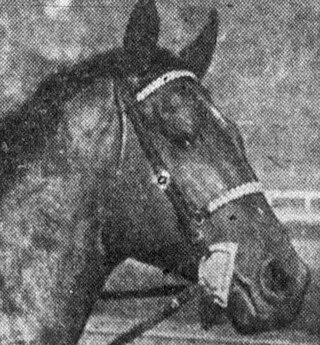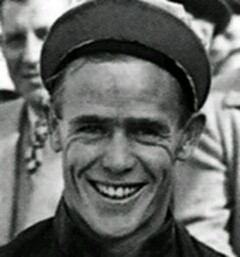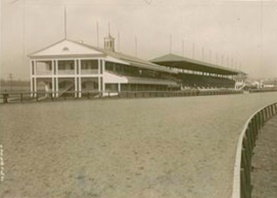Related Research Articles

Citation was a champion American Thoroughbred racehorse who is the eighth winner of the American Triple Crown. He won 16 consecutive stakes races and was the first horse in history to win US$1 million.
Equipoise (1928–1938) was an American Thoroughbred racehorse and sire. In a career which lasted from 1930 until 1935, he ran fifty-one times and won twenty-nine races. A leading two-year-old in 1930, he missed most of the next season, including two of the three American Triple Crown races through injury and illness. "Ekky" returned to the track in 1934 and proved to be a dominant champion, winning numerous important stakes races in the next three years. Equipoise died in 1938 after a short but promising stud career.
The Pimlico Special is a Grade 3 American thoroughbred horse race for horses age three and older over a distance of 1+3⁄16 miles held at Pimlico Race Course in Baltimore, Maryland in mid May. The race currently offers a purse of $250,000.
The Cotillion Stakes is an American Thoroughbred horse race held annually at Parx Racing and Casino in Bensalem, Pennsylvania. It is run in late September or early October as a prelude to the annual Breeders' Cup World Thoroughbred Championships. The race is open to three-year-old filles, willing to race one and one-sixteenth miles on the dirt. The Grade I event carries a purse of US$1 million.
Armed was an American Thoroughbred gelding race horse who was the American Horse of the Year in 1947 and Champion Older Male Horse in both 1946 and 1947. He was inducted into the National Museum of Racing and Hall of Fame in 1963.

Crusader (1923–1940) was an American Thoroughbred racehorse, whose career lasted from 1925 to 1928. In that time, he ran forty-two times and won eighteen races. He was the leading American three-year-old in 1926, winning a number of important races including the Suburban Handicap, the Belmont Stakes and the Dwyer Stakes. He continued to race for a further two seasons, but his form declined after he was injured at Aqueduct Racetrack in June 1927.

Challedon (1936–1958) was an American Hall of Fame Champion Thoroughbred racehorse. Bred in Maryland by William L. Brann and Robert S. Castle, he raced under the colors of their Branncastle Farm.

Albert Snider was a jockey in Thoroughbred racing who had success in his native Canada as well as the United States.

The Havre de Grace Racetrack was an American horse racing track on Post Road in Havre de Grace, Harford County, Maryland. Nicknamed "The Graw," it operated from August 24, 1912, to 1950. For a time, it was owned by the Harford Agricultural and Breeders Association and also by the notorious gambler Arnold Rothstein.
The Havre de Grace Handicap was an American Thoroughbred horse race first run on the August 26, 1912 opening day of the new Havre de Grace Racetrack in Havre de Grace, Maryland. Although most of its runnings would take place in early fall, its final edition was run there on April 30, 1949. Due to Federal government wartime regulations, the 1943 edition was held at Laurel Park and in 1945 at Pimlico Race Course. A race for horses age three old or older, it was run on dirt over a distance of 1 1/8 miles with the exception of 1918 when it was set at 1 mile and 70 yards. From inception through 1939, the race was known as the Havre de Grace Cup Handicap.
Cudgel (1914–1941) was an American two-time Champion Thoroughbred racehorse.
The Potomac Handicap was an American Thoroughbred horse race run annually in the latter part of September at Havre de Grace Racetrack in Havre de Grace, Maryland. Open to three-year-old horses, it was raced on dirt at a distance of a mile-and-a-sixteenth.
Menow (1935–1964) was an American Thoroughbred racehorse. He won several important races in 1937, when he was voted American Champion Two-Year-Old Male Horse.
The Wilson Handicap was an American Thoroughbred horse race run from 1930 through 1958. Inaugurated as the Wilson Stakes at the Saratoga Race Course in Saratoga Springs, New York, it was named in honor of the late Richard Thornton Wilson Jr., a prominent Thoroughbred owner and president of Saratoga Race Course.
Vander Pool was an American Thoroughbred racehorse who won all eleven of his starts at age two in 1930 and won his first four races in 1931, tying the twenty-three-year-old North American record for most consecutive wins without a loss set by Colin in 1907/1908.

Billy Kelly was an American Thoroughbred racehorse who was the champion two-year-old in 1918 when he won 14 of 17 starts. Favored for the 1919 Kentucky Derby, he lost to his stablemate, the then lightly regarded Sir Barton, but Billy Kelly would beat Sir Barton in 8 of 12 head to head races. Billy Kelly would go on to win 39 races from 69 starts. He was elected to the National Museum of Racing and Hall of Fame in 2015.
The Pimlico Cup Handicap was an American horse race for Thoroughbreds run between 1919 and 1961 at Pimlico Race Course in Baltimore, Maryland. A long-distance race on dirt for stayers age three an older, twenty-three of its twenty-five runnings were run at more than two miles.
The Chesapeake Stakes was an important American Thoroughbred horse race for three-year-old horses of either sex contested on dirt over a distance of a mile and one-sixteenth at Havre de Grace Racetrack in Havre de Grace, Maryland. Run from 1920 until the track closed after the 1950 edition, the race usually run in late April race was a last major prep before the Kentucky Derby. For owners who had not nominated their horse for the Derby it was a chance to test their horse's ability against some of the best three-year-olds in the country, a number of which they would undoubtedly encounter in the ensuing Preakness Stakes.
The Eastern Shore Stakes was an American Thoroughbred horse race run between 1913 and 1949 at Havre de Grace Racetrack, in Havre de Grace, Maryland. A race for two-year-old horses of either sex, it was inaugurated and run for most of its existence as the Eastern Shore Handicap.
The Porter was an American Thoroughbred racehorse. He won 26 times from 54 starts in a career that lasted five years, and was second in the 1918 Preakness Stakes. He became an important sire, leading the North American sire list in 1937.
References
- ↑ "Feature Event Won by Ten Point". Montreal Gazette, page 17. 1913-04-28. Retrieved 2020-07-06.
- ↑ "Billy Kelly's Greatness: Illustrated by Impressive Victory in Philadelphia Handicap". Daily Racing Form at University of Kentucky Archives. 1919-04-20. Retrieved 2020-07-07.
- ↑ "Exterminator Is Now Behind $1,409". Montreal Gazette, page 19. 1923-04-23. Retrieved 2020-07-09.
- ↑ "Kilmer Ace Takes Big Stakes Easily". Hanover Evening Sun (Pennsylvania), page 8. 1931-04-20. Retrieved 2020-07-09.
- ↑ "Equipoise Victor In His Debut". New York Times, Section Sports, page 1. 1934-04-22. Retrieved 2020-07-08.
- ↑ "Challedon Beats Mioland by Nose". New York Times, Section Sports, page 6. 1942-04-26. Retrieved 2020-07-03.
- ↑ "Armed, 7-20, Victor at Havre de Grace; Favorite Clips Track Record". New York Times, Section Sports, page 85. 1946-04-21. Retrieved 2020-07-05.
- ↑ "Sir Barton, Billy Kelly and Other Noted Racers Trail Home in Wake of Rank Outsider". New York Times, page 21. 1920-05-01. Retrieved 2020-07-03.
- ↑ "Will Springstead column: A close look at New York-bred horses". The Post-Star. 2017-08-24. Retrieved 2020-07-07.
- ↑ "Thanksgiving Defeats Hypocrite By 4 Lengths at Havre de Grace". New York Times, Section Sports, page 93. 1939-04-30. Retrieved 2020-07-07.
- ↑ "Why Mary Hirsch Belongs In Horse Racing Hall Of Fame". Paulick Report. 2020-01-17. Retrieved 2020-07-07.
- ↑ "Maryland Race Meets Reduced". Reading Eagle, page 20. 1943-02-11. Retrieved 2020-06-22.
- ↑ "Gay Bit Annexes Pimlico Feature". New York Times, Section Sports, page 37. 1945-05-27. Retrieved 2020-07-07.
- ↑ "Pep Well Sets Track Record in Philadelphia 'Cap". The Morning News, page 15. 1947-05-13. Retrieved 2020-07-03.
- ↑ Flatter, Ron. "Citation was the standard". ESPN . Retrieved 2 October 2014.
He was racing's first millionaire horse, earning $1,085,760 in a 45-race career that ran from 1947 to 1951. He won 32 times and was in the money in all but one.
- ↑ "The Pincher 1st In Graw Race Results". The Philadelphia Inquirer, page 32. 1950-04-20. Retrieved 2020-07-05.
- ↑ "'The Graw,' what it was and could still be 100 years later". The Baltimore Sun. 2012-10-12. Retrieved 2020-07-05.